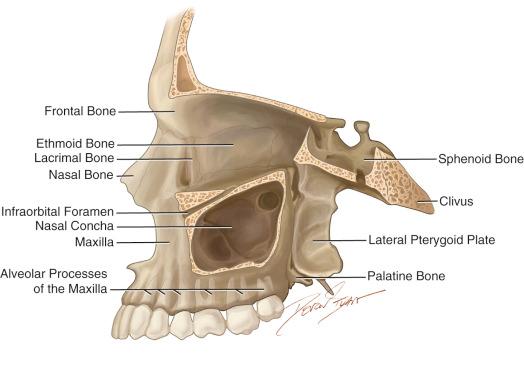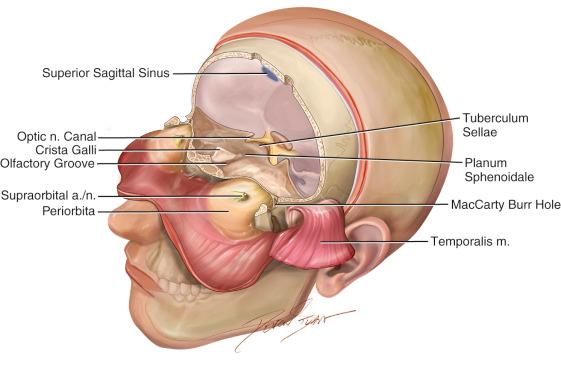Physical Address
304 North Cardinal St.
Dorchester Center, MA 02124
Subfrontal approaches are mainly used to access the floor of the anterior cranial fossa, anterior midline parasellar structures, like the tuberculum sellae, anterior communicating artery, optic chiasm, posterior orbit and orbital apex.
The unilateral subfrontal approach can be adequate for most orbital lesions and midline lesions that are largely eccentric towards one side.
The bifrontal approach is preferable to treat large or midline lesions because it provides a direct wide view through the midline.
Combining the transmaxillary and subfrontal approaches may allow the surgeon to reach the nasal cavity, maxillary sinus, pterygopalatine fossa, pterygoid plates, ethmoid sinuses, medial and inferior orbital walls, sphenoid sinus, nasopharynx, clivus and the medial aspect of the infratemporal fossa and masticatory space. The combined transmaxillary and subfrontal approach is optimal for tumors invading these areas.
Among the tumors amenable to this approach are the esthesioneuroblastomas, squamous cell carcinomas, adenocarcinomas of the paranasal sinuses, olfactory groove meningiomas, chordomas, chondrosarcoma and gangliogliomas.
Patients with less extensive lesions that can be accessed through an endoscopic minimally invasive approach, which avoids cosmetic defects.
Active sinonasal infection.
Other less invasive options to this area may be considered. The endonasal approaches provide direct access to the skull base with less soft tissue manipulation or brain retraction; however, resection of more extensive lesions close to critical neurovascular structures, such as the optic nerve and carotid artery, is limited by the nasal corridor.
Early lesions are often asymptomatic or may be confused with common benign conditions such as chronic sinusitis, allergy or nasal polyposis.
Invasive tumors may produce facial swelling, oral ulcer or a submucosal mass in the palate, and middle ear effusion. Cranial nerves may be involved, presenting with anosmia, blurred vision, diplopia or hypoesthesia, if the trigeminal nerve is affected.
Neuronavigation may be useful to enhance safety and accuracy of tumor resection.
Preoperative computed tomography (CT) and magnetic resonance imaging (MRI) with and without intravenous contrast can be obtained to evaluate tumor extension through the anterior fossa, its relationship to vascular and nervous structures as well as bone invasion.
A multidisciplinary team including neurosurgeons, ophthalmologists and otorhinolaryngologists with reconstructive experience is recommended to plan a surgical approach.
When planning the surgery, it is important to consider that a skin graft may be needed for optimal reconstruction and better cosmetic results. We usually recommend either a pericapsular or temporalis muscle graft.
Medial wall: Formed by the lateral wall of the nasal cavity and the roots of the middle and inferior turbinates (anteriorly) and the perpendicular plate of the palatine bone (posteriorly).
Posterior wall: Limits with the pterygopalatine fossa (medially) and the pterygomaxillary fissure (lateral).
Floor: Formed by the alveolar process of the maxilla.
Lateral wall: Limits with the masticatory space.
Roof: Contains the infraorbital nerve and forms the floor of the orbit.
The maxillary ostium drains to the nasal cavity within the lower third of the hiatus semilunaris at the lateral nasal wall.

Anterior limit — the forehead soft tissue.
Inferior limit — the orbits.
Posterior limit — the anterior cranial fossa.
Separated by a septum between them that frequently deviates to one or the other side of the midline.
It is lined with respiratory epithelium.
The frontal sinus drains into the anterior part of the nasal middle meatus through the nasofrontal duct.
Floor: Formed by the orbital plates of the frontal bone, the cribriform plate and crista galli of the ethmoid bone, and the lesser wings and planum of the sphenoid.
Midline structures: The frontal crest and crista galli anchor the falx cerebri, the olfactory groove, on either side of the crista galli, containing the olfactory bulb and nerves at the cribriform plate.
The anterior ethmoidal artery branches from the ophthalmic artery, within the orbit, then travels medially together with the nasociliary nerve through the anterior ethmoidal canal to the anterior and middle ethmoidal cells (where it can be seen from the endonasal approach).
Branching from the ophthalmic artery, the posterior ethmoidal artery travels between the upper border of the medial rectus and superior oblique muscle to enter the posterior ethmoidal canal. It then exits into the nasal cavity to supply the posterior ethmoidal cells and nasal septum.
The planum and limbus sphenoidale form the roof of the sphenoid sinus, and the anterior margin of the chiasmatic groove.

Become a Clinical Tree membership for Full access and enjoy Unlimited articles
If you are a member. Log in here